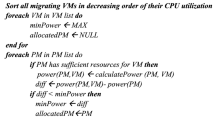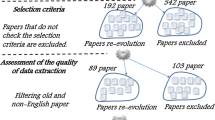Abstract
Nowadays, cloud computing is a growing scenario applied to many scientific and manufacturing areas due to its flexibility for adapting to highly demanding computing requirements. The advantages of pay-as-you-go model, elasticity, and the flexibility and customization offered by virtualization make cloud computing an attractive option for meeting the needs of some high-performance computing (HPC) users. However, in this environment, the inherent resources heterogeneity, the virtual machine resource sharing, and the HPC-agnostic cloud schedulers are some bottlenecks for effective HPC in cloud. Furthermore, the energy factor has added another layer of complexity in the task scheduling because of the necessity of maximizing the resources utilization and reducing their idle states. In such a complex infrastructure, the scheduling process that allocates the user parallel tasks, represented by cloudlets, to the virtual machines becomes the focus not only to reduce the job execution times, but also to deal with the energy-performance trade-off. In this work, we propose a multi-objective genetic algorithm to determine the most suitable allocation of cloudlets to the available virtual machines. This innovative approach is able to generate scheduling decisions evading systematic allocations and providing new chances for the remaining cloudlets to be scheduled in order to reduce the whole execution time and also the energy consumption. We validated our proposal using real workload traces from HPC environments and compared the results with well-known algorithms from the literature. The obtained results showed that our proposal achieves lower execution times and minimum energy consumption compared with other classic algorithms from the literature.





Similar content being viewed by others
References
Iosup A, Ostermann S, Yigitbasi MN, Prodan R, Fahringer T, Epema D (2011) Performance analysis of cloud computing services for many-tasks scientific computing. IEEE Trans Parallel Distrib Syst 22(6):931–945
Gupta A, Kalé LV (2013) Towards efficient mapping, scheduling, and execution of hpc applications on platforms in cloud. In: 2013 IEEE International Symposium on Parallel Distributed Processing, Workshops and Ph.D. Forum, pp 2294–2297
André BL, Urs H (2007) The case for energy-proportional computing. Computer 40(12):33–37
Beloglazov Anton, Buyya Rajkumar (2012) Optimal online deterministic algorithms and adaptive heuristics for energy and performance efficient dynamic consolidation of virtual machines in cloud data centers. Concurr Comput 24(13):1397–1420
Mann Zoltán Adám, Szabó Máté (2017) Which is the best algorithm for virtual machine placement optimization? Concurr Comput 29(10):e4083
Geetha V, Devi RA, Ilavenil T, Begum SM, Revathi S (2016) Performance comparison of cloudlet scheduling policies. In: 2016 International Conference on Emerging Trends in Engineering, Technology and Science (ICETETS), pp 1–7
Binitha S, Sathya SS et al (2012) A survey of bio inspired optimization algorithms. Int J Soft Comput Eng 2(2):137–151
Agarwal A, Jain S (2014) Efficient optimal algorithm of task scheduling in cloud computing environment. CoRR, abs/1404.2076
Patel Gaurang, Mehta Rutvik, Bhoi Upendra (2015) Enhanced load balanced min-min algorithm for static meta task scheduling in cloud computing. Procedia Comput Sci 57:545–553
Rathor VS, Pateriya RK, Gupta RK (2015) An efficient virtual machine scheduling technique in cloud computing environment. Int J Mod Educ Comput Sci 7(3):39
Singh Shekhar, Kalra Mala (2014) Task scheduling optimization of independent tasks in cloud computing using enhanced genetic algorithm. Int J Appl Innov Eng Manag 3(7):2319–4847
Liu Jing, Luo Xing-Guo, Zhang Xing-Ming, Zhang Fan, Li Bai-Nan (2013) Job scheduling model for cloud computing based on multi-objective genetic algorithm. IJCSI Int J Comput Sci Issues 10(1):134–139
Tawfeek MA, El-Sisi A, Keshk AE, Torkey FA (2013) Cloud task scheduling based on ant colony optimization. In: 2013 8th International Conference on Computer Engineering Systems (ICCES), pp 64–69
Bhoi U, Ramanuj PN et al (2013) Enhanced max-min task scheduling algorithm in cloud computing. Int J Appl Innov Eng Manag (IJAIEM) 2(4):259–264
Goyal Tarun, Agrawal Aakansha (2013) Host scheduling algorithm using genetic algorithm in cloud computing environment. Int J Res Eng Technol (IJRET) 1(1):7–12
Cocaña-Fernández Alberto, Sánchez Luciano, Ranilla José (2016) Leveraging a predictive model of the workload for intelligent slot allocation schemes in energy-efficient hpc clusters. Eng Appl Artif Intell 48:95–105
Cocaña-Fernández Alberto, Sánchez Luciano, Ranilla José (2016) Improving the eco-efficiency of high performance computing clusters using eecluster. Energies 9(3):197
Cocaña-Fernández A, Rodríguez-Soares J, Sánchez L, Ranilla J (2017) Improving the energy efficiency of virtual data centers in an it service provider through proactive fuzzy rules-based multicriteria decision making. J Supercomput 1–16
Saborido R, Ruiz AB, Luque M (2017) Global wasf-ga: an evolutionary algorithm in multiobjective optimization to approximate the whole pareto optimal front. Evol Comput 25(2):309–349
Gabaldon E, Lérida J, Guirado F, Planes J (2017) Blacklist multi-objective genetic algorithm for energy saving in heterogeneous environments. J Supercomput 73(1):354–369
Feitelson D (2005) Parallel workloads archive. http://www.cs.huji.ac.il/labs/parallel/workload
Feitelson DG, Tsafrir D, Krakov D (2014) Experience with using the parallel workloads archive. J Parallel Distrib Comput 74(10):2967–2982
Calheiros RN, Ranjan R, Beloglazov A, De Rose CAF, Buyya R (2011) Cloudsim: a toolkit for modeling and simulation of cloud computing environments and evaluation of resource provisioning algorithms. Softw Pract Exp 41(1):23–50
Acknowledgements
This work has been supported by the MEyC-Spain under contract TIN2014-53234-C2-2-R, TIN2016-81840-REDT, and TIN2017-84553-C2-2-R.
Author information
Authors and Affiliations
Corresponding author
Rights and permissions
About this article
Cite this article
Vila, S., Guirado, F., Lerida, J.L. et al. Energy-saving scheduling on IaaS HPC cloud environments based on a multi-objective genetic algorithm. J Supercomput 75, 1483–1495 (2019). https://doi.org/10.1007/s11227-018-2668-z
Published:
Issue Date:
DOI: https://doi.org/10.1007/s11227-018-2668-z




